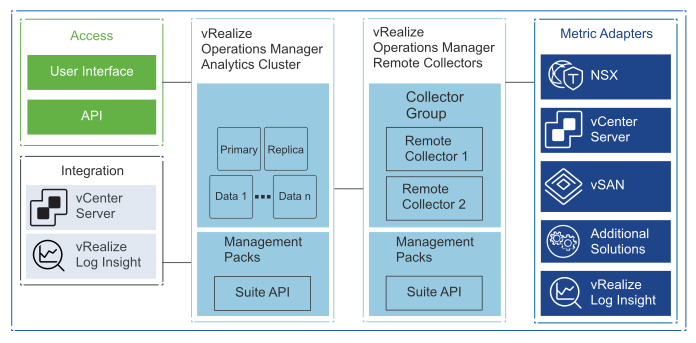vRealize Operations Manager communicates with all management components to collect metrics that are presented through various dashboards and views.

The analytics cluster of the vRealize Operations Manager deployment contains the nodes that analyze and store data from the monitored components. You deploy a configuration of the analytics cluster that meets the requirements for monitoring the number of VMs.
Deploy a three-node vRealize Operations Manager analytics cluster that consists of one primary node, one replica node, and one data node to enable scale-out and high availability.
This design uses medium-size nodes for the analytics cluster and standard-size nodes for the remote collector group. To collect the required number of metrics, add a virtual disk of 1 TB on each analytics cluster node.
You can use the self-monitoring capability of vRealize Operations Manager to receive alerts about issues that are related to its operational state.
vRealize Operations Manager displays the following administrative alerts:
-
System alert: Indicates a failed component of the vRealize Operations Manager application.
-
Environment alert: Indicates that vRealize Operations Manager stopped receiving data from one or more resources. This alert might indicate a problem with system resources or network infrastructure.
-
Log Insight log event: Indicates that the infrastructure on which vRealize Operations Manager is running has low-level issues. You can also use the log events for root cause analysis.
-
Custom dashboard: vRealize Operations Manager shows super metrics for data center monitoring, capacity trends, and single pane of glass overview.
| Design Recommendation |
Design Justification |
Design Implication |
|---|---|---|
| Deploy vRealize Operations Manager as a cluster of three nodes:
|
|
All the nodes must be sized identically. |
| Deploy two remote collector nodes. |
Removes the load from the analytics cluster from collecting application metrics. |
When configuring the monitoring of a solution, you must assign a collector group. |
| Deploy each node in the analytics cluster as a medium-size appliance. |
Provides the scale required to monitor the solution. |
ESXi hosts in the management cluster must have physical CPUs with a minimum of 8 cores per socket. In total, vRealize Operations Manager uses 24 vCPUs and 96 GB of memory in the management cluster. |
| Add more medium-size nodes to the analytics cluster if the number of VMs exceeds 10,000. |
Ensures that the analytics cluster has enough capacity to meet the VM object and metric growth. |
|
| Deploy the standard-size remote collector virtual appliances. |
Enables metric collection for the expected number of objects. |
You must provide 4 vCPUs and 8 GB memory in the management cluster. |
| Add a virtual disk of 1 TB for each analytics cluster node. |
Provides enough storage for the expected number of objects. |
You must add the 1 TB disk manually while the VM for the analytics node is powered off. |
| Configure vRealize Operations Manager for SMTP outbound alerts. |
Enables administrators and operators to receive email alerts from vRealize Operations Manager. |
Requires access to an external SMTP server. |